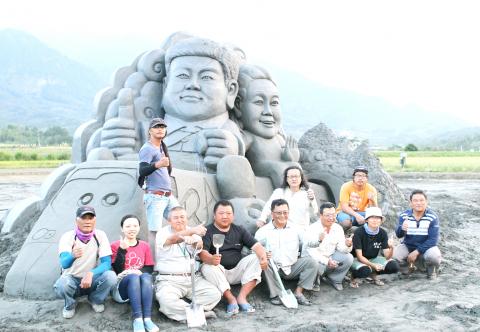With only six days remaining before the Nov. 29 nine-in-one elections, some Hualien County residents said they were “disgusted” when they found a sand sculpture of Hualien County Commissioner Fu Kun-chi (傅崑萁) and his wife placed conspicuously at the venue of a local flower festival scheduled for next month, calling it an act of “brown-nosing.”
Fu, an independent seeking re-election, is currently appealing to the Supreme Court in the hopes that the judges will overturn a ruling the High Court passed down in August last year that sentenced him to three years in prison for speculative stock trading.
His wife, Hsu Chen-wei (徐榛蔚), has also registered as a Hualien commissioner candidate, which has been widely seen as a contingency plan in case her husband is indicted prior to the election.

Photo: CNA
Earlier this month, the Fuli Township Farmer’s Association commissioned sand carving artist Yeh Kun-ting (葉坤定) to create the piece, which was nearing completion yesterday.
The artwork, made of soil dug from the fields, features caricatures of Fu and his wife sitting on top of the Taiwan Railways Administration’s Taroko Express, with Fu giving the thumbs-up gesture, prompting speculation that the piece was created to further Fu’s political aims, given the elections next week.
The sculpture, meant to promote the flower festival slated for next month, drew some criticism from passers-by.
“Isn’t that the commissioner and his wife? That’s disgusting,” one said.
“Whoever did this must be really desperate to brown-nose,” another said.
In response, Fuli Township Farmer’s Association Promotion division head Lin Hui-huang (林輝煌) said that Fu has taken the Taroko Express north many times to help market the county’s agriculture and horticulture, touting him as “local farmers’ best friend.”
The sand sculpture of Fu giving the thumbs-up sign is meant to show Fu’s solidarity with local farmers, not meant to suck up to him, he said.

US climber Alex Honnold is to attempt to scale Taipei 101 without a rope and harness in a live Netflix special on Jan. 24, the streaming platform announced on Wednesday. Accounting for the time difference, the two-hour broadcast of Honnold’s climb, called Skyscraper Live, is to air on Jan. 23 in the US, Netflix said in a statement. Honnold, 40, was the first person ever to free solo climb the 900m El Capitan rock formation in Yosemite National Park — a feat that was recorded and later made into the 2018 documentary film Free Solo. Netflix previewed Skyscraper Live in October, after videos

NUMBERS IMBALANCE: More than 4 million Taiwanese have visited China this year, while only about half a million Chinese have visited here Beijing has yet to respond to Taiwan’s requests for negotiation over matters related to the recovery of cross-strait tourism, the Tourism Administration said yesterday. Taiwan’s tourism authority issued the statement after Chinese-language daily the China Times reported yesterday that the government’s policy of banning group tours to China does not stop Taiwanese from visiting the country. As of October, more than 4.2 million had traveled to China this year, exceeding last year. Beijing estimated the number of Taiwanese tourists in China could reach 4.5 million this year. By contrast, only 500,000 Chinese tourists are expected in Taiwan, the report said. The report

Temperatures are forecast to drop steadily as a continental cold air mass moves across Taiwan, with some areas also likely to see heavy rainfall, the Central Weather Administration (CWA) said. From today through early tomorrow, a cold air mass would keep temperatures low across central and northern Taiwan, and the eastern half of Taiwan proper, with isolated brief showers forecast along Keelung’s north coast, Taipei and New Taipei City’s mountainous areas and eastern Taiwan, it said. Lows of 11°C to 15°C are forecast in central and northern Taiwan, Yilan County, and the outlying Kinmen and Lienchiang (Matsu) counties, and 14°C to 17°C

STEERING FAILURE: The first boat of its class is experiencing teething issues as it readies for acceptance by the navy, according to a recent story about rudder failure The Hai Kun (海鯤), the nation’s first locally built submarine, allegedly suffered a total failure of stern hydraulic systems during the second round of sea acceptance trials on June 26, and sailors were forced to manually operate the X-rudder to turn the submarine and return to port, news Web site Mirror Daily reported yesterday. The report said that tugboats following the Hai Kun assisted the submarine in avoiding collisions with other ships due to the X-rudder malfunctioning. At the time of the report, the submarine had completed its trials and was scheduled to begin diving and surfacing tests in shallow areas. The X-rudder,